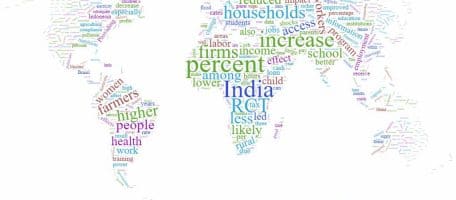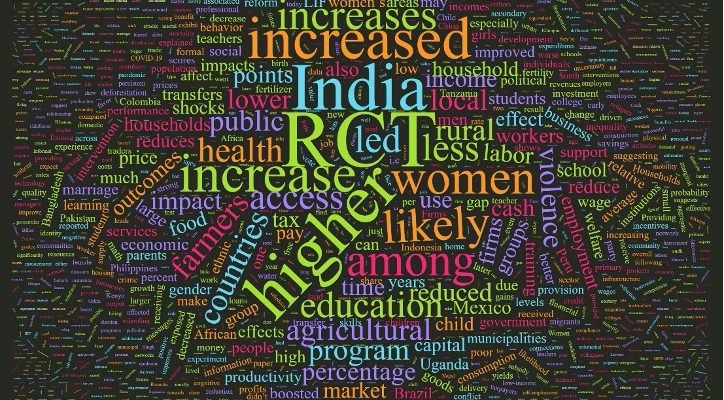
A round-up of nearly one hundred studies from CSAE 2021
From 15-26 March, for the second time, the annual conference by the Centre for the Study of African Economies at Oxford University was held virtually. The conference received nearly 100 papers on topics from political economy, to service provision in health and education, to agriculture, labour, trade, and environment. This post by David Evans summarises the findings of these papers, noting the research method used next to each study (explanation in the box below). The countries most heavily represented are Kenya (8 papers), Uganda (7), Ghana (5), and Tanzania (5), Ethiopia (4), Nigeria (4), Mozambique (3), Rwanda (3), and South Africa (3). Nine papers drew on data from multiple African countries, and there are single studies from a wide range of other countries, including the Central African Republic, Côte d’Ivoire, Guinea-Bissau, Senegal, and Togo.
- How do conflict and land access affect households’ choice of herd size and type of livestock? In Nigeria, exposure to conflict reduced herd size and encouraged diversifying across (and focusing on smaller) species. Access to land counteracts most of these effects: it increases herd size and encourages specialization, but still with smaller livestock. (Fadare, Zanello, and Srinivasan) #DID
- How does conflict affect agricultural productivity? What about conflict and land cultivation? In the Central African Republic, the presence of conflict in the previous year reduces farmers’ land preparation (as measured by fewer fires to clear the land) and their agricultural production. “These decreases are suggestive of the abandoning of farmlands due to conflict.” (Blankespoor, Touray, and Katayama) #DID
- Civil conflict in Mali “had a negative impact on agriculture production and livestock holdings.” Food assistance countered the negative effect of conflict on livestock holdings, but not on farm production. (Masset et al.) #DID
- Subsidizing watchmen to prevent theft on farms in Kenya improved output per acre by 15 percent without displacing crime to nearby villages. Farmers were more likely to try new crops or plant more, but the benefit experienced by individual farmers does not outweigh the cost of hiring a watchman. (Dyer) #RCT
- Electrifying villages in Ethiopia made them more likely to benefit from an irrigation system, which then went on to improve their agricultural labor productivity. (Dorinet) #IV
- How do public health interventions affect agricultural productivity? In Burkina Faso, eliminating schistosomiasis (a water-based disease endemic in low- and middle-income countries) could increase crop yields by 7 percent on average and by 32 percent in areas with high rates of infection. The construction of dams and reservoirs, while they directly boost agricultural yields, can also have negative indirect effects by facilitating the spread of the disease. (Rinaldo) #IV
- Comparing land on two sides of rivers in Mozambique suggests that land better connected to roads is more likely to be cultivated but not necessarily managed differently. (von Carnap et al.)
- In Uganda, a mobile phone-based marketplace for agricultural commodities increased trade flows and reduced price divergence, but only for the largest farmers who could reach the scale required to find buyers on the platform. (Bergquist and McIntosh) #RCT
- Groundnut farmers in Senegal were offered a new contract that guaranteed a price premium and provides training and credit for the purchase of a new technology to improve quality. (The technology reduced fungi on the groundnut plants.) The farmers were “significantly more likely to purchase and use the technology” and “to comply with international quality standards” (for farmers in areas where the quality of groundnuts was traditionally low). (Deutschmann, Bernard, and Yameogo) #RCT
- Village-level data on land use and crop suitability in Uganda suggest that agricultural productivity “could be increased by one third just by reallocating crops, even among “narrowly defined areas serving the same urban markets.” (Morando)
- Farmers who received free weekly updates on their mobile phones about the cashew market (news, prices, and marketing advice based on trends) engaged in more sales, whereas other farmers “tended to concentrate their sale in one large transaction.” Average price for sale was lower in the group receiving updates, but total value of all sales was significantly higher. (Pereira et al.) #RCT
- Firms in Zimbabwe face financial access constraints (i.e. higher demand for funds than what’s available), especially “productive, young, and small firms.” A smaller number of financially constrained firms invests, leading to lost productivity, but average employment growth seems to be unaffected by constraints. (Kamutando)
- A two-decade large-scale road and electricity network expansion in Ethiopia increased welfare by at least 11% compared to no investment. “Access to an all-weather road…increases services employment, at the expense of manufacturing.” But access to a road together with access to electricity increases manufacturing. (Moneke) #IV
- A field experiment in Ethiopia subsidized formal employee search (“online and offline job boards and newspaper advertisements”) with no impact on vacancy creation and hires. After the subsidy ran out, firms went back to informal network-based hiring, although some firms observed “a lasting and significant increase in their demand for white collar workers.” (Hensel, Tekleselassie, and Witte) #RCT
- Offering a digital phonebook to small firms in Tanzania increased “relational contracting” (receiving and giving benefits beyond what’s usual in anonymous transactions) with their suppliers and decreased it with their customers, but there’s no evidence that it actually increased the number of customers or suppliers. (Rudder) #RCT
- Installing monitoring devices that track real-time vehicle driving behavior and daily productivity of commuter minibuses in Kenya improved efficiency and reduced risky driving. Owners with access to the monitoring device reduced daily revenue targets for drivers. In turn, drivers worked longer hours “but engaged in substantially less damaging driving such as off-road driving, earning about the same amount of revenue as before” while saving the owner maintenance costs. After six months, owners were expanding their minibus businesses. (Kelley, Lane, and Schönholzer) #RCT
- Does financial misconduct impair market efficiency? In Ghana, two anti-misconduct information campaigns for mobile money vendors and consumers were designed to improve price transparency (“what to ask while at banking points”) or to inform users how to monitor and report (“how to report transactional glitches or misconduct”). The programs decreased incidence of vendor misconduct, increased uptake of transactional services, and improved savings behavior. “While overall poverty levels did not decrease, it significantly decreased for female customers” by eliminating “existing gender gaps in uptake and savings behavior.” (Annan and Sanoh) #RCT
- Following the devastation of Cyclone Idai in Mozambique in 2019, cash grants to micro businesses “had a positive effect on firm income, profit, savings and roof repair.” The grant had a stronger impact in locations that experienced more severe damage. (Berkel, Fisker, and Tarp) #RCT
- In a market with perfect competition, cash transfers will increase demand, which should mean higher prices. New businesses then come in to drive prices down, benefitting transfer recipients. But what happens when new businesses cannot compete? A cash transfer program for refugees in Kenya only allowed the money to be spent at licensed businesses. This resulted to higher profit for the licensed businesses but also inflated prices. (Delius and Sterck) #PSM
- Access to high-speed internet in Africa increased innovation within firms, particularly in firms with “advanced digital skills.” It also boosted entrepreneurship in the service sector. (Houngbonon, Mensah, and Traore) #DID #IV
- When Malawi faced multiple droughts and floods during 2014-2016, households exposed to weather shocks in sequential years reduced both food and non-food consumption, as compared to households exposed to just one weather shock, who were able to maintain their food-consumption levels. Household poverty level was not a significant predictor of aid receipt during weather shocks, suggesting a need for better targeting. (Kilic) #IV
- Households in Côte d’Ivoire where husbands attended a training for rubber farming without their wives saw a 26 percent drop in total harvest and an 18 percent drop in yield. (This isn’t unusual since newly planted rubber plants can take six years before they mature for harvest.) But households where husbands and wives both attended the training planted 20 percent more rubber seedlings and kept their yield constant using “older trees and other crops.” (Donald, Goldstein, and Rouanet) #RCT
- Entrepreneurs in Benin who formalize their microbusinesses–both women and men–have more control over household revenue and contribute less to household expenses and their partners’ personal expenses. Women entrepreneurs who formalize their businesses are much more willing to pay to hide a windfall from their spouse. (Pouliquen) #RCT
- Pre-pandemic face-to-face surveys followed by later phone surveys in Nigeria reveal that “lockdown measures increased households’ experience of food insecurity by 13 percentage points and reduced the probability of participation in non-farm business activities by 11 percentage points.” (Amare et al.) #DID
- Weekly financial diaries in Kenya reveal that the COVID-19 pandemic reduced work income by almost a third and reduced income from gifts and remittances by more than a third. Households postponed loan repayments, gave out fewer gifts and remittances, and lent less money to others. (Janssens et al.)
- Households in rural Uganda lost 60 percent of their non-farm income as a result of lost business and labor income during the pandemic lockdown. Coping mechanisms included cutting 40 percent of food expenditure, using up to half of savings, borrowing more, and using the additional available labor in farming and livestock. (Mahmud and Riley)
- Who needs an impact evaluation? 20,000 forecasts of the impacts of experiments in Kenya show that “average predicted effects track experimental results well.” People similar to those receiving the intervention predict results well for interventions likely to be familiar to them, but academics predict better on average. The average forecast of each group is more accurate than 75 percent of the individual forecasts, evocative of the “wisdom of crowds” idea. Among academics, confidence, citations, and experience doing research in East Africa do not predict accuracy of forecasts. (Otis)
- Nigerian women who received cash transfers are more likely to start a business of their own (6 percentage points). One year after the transfers stopped, beneficiary women and their neighbors (spill-over effects!) are more likely to have a business than in villages without the cash transfer program. (Friedman et al.) #RCT
- Can hosting refugees create market opportunities? In Uganda, home to the largest refugee population in Africa, a decrease of one kilometer in distance from refugee households increases “hosts’ wage income by about 25 percent.” But the effects fade for distances over five kilometers. (d’Errico et al.) #IV
- A field experiment in Ethiopia invited unemployed youth to self-affirmation and goal-setting workshops. The workshops improved the likelihood of employment, days worked, and earnings for men (especially those men who believed they had little control over their lives), but did not shift outcomes for women. Getting women into the labor force “requires addressing access to childcare” and expectations around household obligations. (Mejía-Mantilla and Walsh) #RCT
- Can you learn how to use LinkedIn more effectively? A randomized evaluation in South Africa trained workseekers to join and use LinkedIn: it improved their employment rate by 7 percentage points. Effects persisted a year later. (Wheeler et al.) #RCT
- Early childbearing was associated with “a large, negative, and significant … effect on literacy and educational attainment,” and with reduced labor market prospects (via literacy), according to data from Cameroon, Uganda, Ghana, and Gabon. (Age at menarche serves as an instrumental variable.) (Burger et al.) #IV
- “South Africa currently has the highest rate of youth unemployment … in the world.” Individuals who are unemployed once are highly likely to be unemployed again, such that “early policies reducing short-run unemployment would have long term effects.” (Eigbiremolen)
- New university graduates in Mozambique tend to have over-optimistic expectations about how much they’ll earn. Providing information on earnings by previous graduates lowered the salary expectation of new graduates, initially by 7 percent and then by 13 percent in the long run. The only thing that lowered expectations more was the receipt of an actual salary offer. (Jones) #RCT
- After South Africa introduced a minimum wage for agricultural workers in 2003, employers in the agricultural sector were more likely to fire workers during a bad year. (Sharp) #DID
- The opening of industrial mines in Mali decreased children’s working hours by 8.6 hours per week, with bigger effects for girls. The effects came “through higher household income and increased mothers’ presence at home.” But the reduced working hours for children did not translate to improvements in children’s educational outcomes. (Son) #DID
- A cash transfer in Kenya improved the diets of both the households receiving the transfer and non-recipient households in the same communities, potentially through “sharing the … transfers among social network members.” Recipients also increased their savings and access to credit. (Ongudi and Thiam) #DID
- “Using data on 84 developing countries over the period 1980-2013, we find a positive long-run association between aid and taxes… Higher bureaucratic costs of aid (as measured by high donor fragmentation) create instability in aid,” which reduces local tax collection. (Tagem)
- In Tanzania, insecure land property rights are “associated with resource misallocation and market incompleteness.” A model predicts gains for both agricultural and non-agricultural output from land reform. (Manysheva)
- During the COVID-19 pandemic, countries that were “eligible for official debt relief experience a larger decline in borrowing costs compared to similar, ineligible countries.” The drop in borrowing costs is bigger for “countries that receive” more debt relief. (Lang, Mihalyi, and Presbitero)
- Is Africa de-industrializing? No. After conditioning on income, population, and fixed differences across countries, “manufacturing output shares show positive and statistically significant trends over time… Africa is not deindustrializing, although there has not been any significant industrial development since the 1970s.” (But Southern Africa is the exception!) (Mensah)
- Across 48 African countries over 17 years, “an increase in corruption by one standard deviation is associated with a decrease in the proportion of capital expenditure from 29% to 16%… it seems more beneficial for corrupted bureaucrats to manipulate public spending in favor of current rather than capital expenditures.” (Sedgo and Omgba)
- International financial institutions have encouraged a shift in taxation towards domestic sales taxes, especially the value added tax. However, these taxes are regressive, since poorer households spend more on consumption. Indeed, simulations in Togo suggest that such a shift increases poverty! (Adandohoin)
- In the Democratic Republic of the Congo, a randomly assigned tax reduction at different levels shows that lowering tax rates actually increased revenues. Better tax collectors allow a higher optimal tax rate. (Bergeron, Tourek, and Weigel)
- A community-driven development program in Somalia that required community contributions (i.e., via matching grants) “had positive effects on the capacity of communities to undertake development projects, to raise informal taxes, and to produce higher quality public goods.” (van den Boogaard and Santoro) #RCT
- Do armed groups “use sexual violence as a strategy to extort economic resources” from civilians? Data from sexual violence against civilians by armed groups in “all African countries” from 1997 to 2018 reveal that “one standard deviation increase in the value of gold mined in artisanal mining areas – a labor intensive and easy to conceal resource – increases sexual violence by two-third of the sample mean.” (Fourati, Girard, and Laurent-Lucchetti)
- How can climate change drive conflict? “Ethnographic and conflict data in Africa from 1989 to 2018” suggest that “droughts in pastoral areas lead to conflict in neighboring agricultural areas.” As arid regions of Africa expand, “agro-pastoral conflict is caused by the displacement of pastoral groups due to low precipitation in their homelands.” (McGuirk and Nunn)
- During the Rwandan genocide, villages that experienced more male-targeted violence may have also experienced a power vacuum that empowered women: “women in high-violence villages are healthier, better educated, wealthier, hold more decision-making power, are less likely to accept and experience domestic violence, work in better jobs, and enjoy more sexual and financial autonomy.” (Rogall and Zárate-Barrera) #IV
- Do cash transfers sway elections? In Kenya, cash transfers in advance of an election neither affected turnout in the national election nor swayed household members’ opinions of local candidates. “Voters (correctly) do not attribute the programme to their local leader.” (Orkin and Walker) #RCT
- Political inequality takes multiple forms: “gaps in citizens’ voice (input inequality), in the degree of responsiveness of political systems (throughput inequality), and in the ways political decisions favor different groups of citizens differently (output inequality).” An experiment with consultative meetings in Kampala, Uganda found “clear evidence” of the first type of inequality and moderate evidence of the second, with men and Luganda speakers benefiting, but no evidence of output inequality. (Bosancianu, Garcia-Hernandez, and Humphreys) #RCT
- A school reform in Liberia that outsourced public school management to private operators increased school attendance and test scores. But it also lost votes for the responsible party’s presidential candidate. Why? Potentially because the reform led to a highly-publicized dismissal of teachers by a private operator which reduced “teachers’ support for the incumbent government – especially among unionized teachers.” (Sandholtz) #RCT
- Providing monetary incentives to community-based volunteers in Zambia — to be paid out if more women were referred or accompanied to antenatal care visits — did not significantly increase the number of visits overall; it just increased the number of accompanied visits. Institutional deliveries rose. (Chama-Chiliba et al.) #RCT
- “The malaria control program in Nigeria that involves community health workers resulted in lower malaria prevalence, but had a significantly negative impact on physical growth for children under five.” What?! This was potentially because the malaria program’s increased demand for community health workers reduced poor households’ access to other health services. (Dong) #RCT
- Training teachers in Ghana to target instruction to the current learning level of the student boosted learning outcomes. Adding training of school managers did not further boost learning, although it did boost measures of management quality. (Beg, Fitzpatrick, and Lucas) #RCT
- A school feeding program in Rwanda improved student test scores (“with the impact accruing over time”) and narrowed the gender gap in student performance, yielding an estimated “11:1 return on investment.” (Mensah and Nsabimana) #DID
- How has education quality changed over time? Data from 87 countries between 1950 and 2000 show that “cross-country differences in education quality are strikingly persistent: top performers like Burundi and Vietnam have seen table performance over decades. A few large developing countries…have experienced significant declines in education quality, while almost no country in our sample has seen a significant improvement.” (Le Nestour, Moscoviz, and Sandefur)
- In Tanzania, setting goals improved students’ time use, study effort, and self-discipline but did not improve test scores, mostly because most students (two-thirds) set unrealistic goals. Adding recognition of students with high performance led to smaller gains than setting goals alone. (Islam et al.) #RCT
- Based on data from school construction in Egypt in the 1960s and 70s, “the opening of a new university in an individual’s province increases the likelihood of obtaining a university degree … by 11 percent. The impact is driven mainly by women, as social norms limit their mobility to get higher education elsewhere.” (Elsayed and Shirshikova) #DID
- Using the 1980 education reform in Zimbabwe which increased access to education, the study finds that “schooling has a significant negative effect on HIV status and the propensity to stigmatize people living with HIV and AIDS.” (Njowke and Kijima) #RD
- What do we learn from 145 recent empirical studies of education in Africa? Structured pedagogy, mother tongue instruction, and school feeding all deliver learning gains. (Evans and Mendez Acosta) #Review
- Across 350 public primary schools in Tanzania, “approximately 96% of teachers support the idea of teacher performance pay, while 61% favour at least some performance-linked element in a future salary increase.” A small “majority of parents (55%) prefer performance pay over school grants.” (Mbiti and Schipper) (Working paper)
- In Rwanda, 20 percent of teachers leave their jobs each year. There is high teacher turnover in schools with low learning levels, low pupil-teacher ratios (yes, you read that right), among early-career teachers, and among male teachers. 23 percent of “exiting teachers are not replaced the following year.” Teacher turnover leads to lower learning outcomes. (Zeitlin) (Open source)
- In Kagera (Tanzania), “if females manage to get post-primary education (which we know is harder), this helps them much more than males to get a skilled or professional job” (excerpt from the presentation). (Kamanzi et al.) #IV
- How different is China from other investors in Africa? “The main drivers behind location choice are similar for Chinese and non-Chinese investors,” but Chinese investments are more responsive to the size of the market. In particular, “Chinese investors target the large and growing economy of South Africa much more frequently than other investors.” (Benfratello, D’Ambrosio, and Sangrigoli)
- “An additional dry rainy season” in a given area of Kenya leads to a drop in population growth in that area, with most of the out-migration (about 58 percent) by men. (Gittard) #FE
- “The competition created by industrial fishing vessels overfishing African seas and depleting fish stocks” increases “the number of asylum seekers to OECD in general and of male asylum seekers to European OECD countries in particular.” (Hu and Libois) #FE
- Trade liberalization in Ghana may have “led to the trend of de-industrialization that many African economies are experiencing.” (Ayoade-Alabi) #SC
- Fewer Chinese workers go to parts of Africa with high malaria risk, although this is less true for Chinese workers from parts of China with “historically high malaria risk.” (Cervellati et al.)
- Droughts in Niger exacerbate the seasonality of food prices, with lower millet prices right after harvest but much higher prices later during the lean season. (Kakpo et al.)
- An agricultural extension program in Uganda boosted agricultural productivity and actually “reduced deforestation by 13” percent. “Suitably designed programs improving agricultural productivity may also enable conservation.” (Abman et al.) #RD
- Human settlements in Ghana over the last 40 years have grown, mostly near roads and the coast. Looking to the future, “we predict a sharp increase in the proportion of the country that is densely built-up by the middle and the end of the century… Based on current trends, we do not expect urban growth in Ghana to take the form of urban sprawl.” (Fafchamps and Shilpi)







